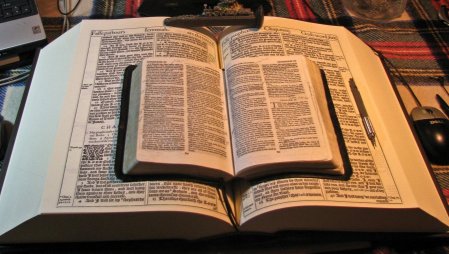
In the Preface to the 1611 edition, the translators of the Authorised Version (AV - as it is known in England) or King James Version of the Bible (KJV - as it is known in America) state that it was not their purpose "to make a new translation...but to make a good one better." Indebted to the earlier work of William Tyndale and others, they saw their best contribution to consist in revising and enhancing the excellence of the English versions which had sprung from the Reformation of the 16th century.
The first English version of the Scriptures was made by direct translation from the Hebrew and Greek manuscripts (MSS) available at the time, and the first to be printed was the work of William Tyndale who produced the very excellent Coverdale Bible (1535) which this writer still consults from time to time. He met bitter opposition. He was accused of willfully perverting the meaning of the Scriptures, and his New Testaments were ordered to be burned as 'untrue translations'. He was finally betrayed into the hands of his enemies, and in October 1536, was publicly executed and burned at the stake.
Yet Tyndale's work became the foundation of subsequent English versions, notably those of Coverdale (1535), Thomas Matthew (probably a pseudoymn for John Rogers - 1537), the Great Bible (1539), the Geneva Bible (1560) and the Bishops' Bible (1568). In 1582, a translation of the New Testament, made from the Latin Vulgate by Roman Catholic scholars, was published at Rheims.
The translators who made the King James Version took into account all of these preceding versions and comparison shows that it owes something to each of them. It kept felicitous phrases and apt expressions, from whatever source, which had stood the test of public usage. It owed most, especially in the New Testament, to Tyndale.

In 1603, James I commissioned 54 of the most learned men in the universities to undertake the new work. Seven of these died before the work could begin, leaving the remaining 47 to be divided into six groups or 'companies', each of which met at a different place and prepared different portions of the Scriptures, though the whole of that portion was to be translated by every person in that company. Then each of the versions by the members of that company were compared. When any one company had finished its assignment, it was shared with all the other scholars so that nothing might be accepted without unanimous consent. If any objection was made, the passage was returned for amendment or, in the case of any disagreement, it was referred to the General Committee consisting of one principal person from each company.
Company I met at Westminster and consisted of 10 persons who translated from Genesis to the end of 2 Kings. Company II met at Cambridge, consisted of 8 members, and translated from 1 Chronicles to the end of the Song of Solomon. Company III met at Oxford and consisted of 8 individuals, who translated the remainder of the Tanakh (Old Testament). Company IV assembled at Cambridge, included 7 persons, and translated the Apocrypha (most KJV Onlyers are not aware that the 1611 KJV contained the Catholic-approved Apocrypha). Company V met at Oxford, consisted of 8 members, and translated the Four Gospels, Acts and Revelation. Finally, Company VI met at Westminster, and included 7 persons, who were appointed to translate the Epistles.
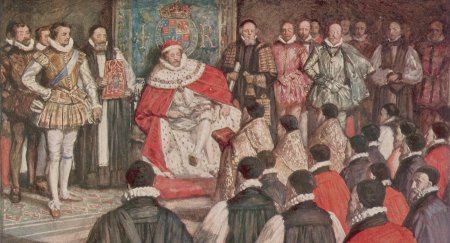 King James and His 54 (47) Bible Scholars
King James and His 54 (47) Bible Scholars
The translation started in the spring of 1607 and took almost three years. Three copies of the final work were made at Westminster, Oxford and Cambridge. The Bishop's Bible contributed the largest volume of the KJV text though several of the other older English translations, as well as some of those of the continental languages, were also used as auxilliaries. When the work was finished, the General Committee met at Stationer's Hall and reviewed and polished it. A final revision was made by Dr. Miles Smith, Anglican Bishop of Gloucester, and by Dr. Thomas Bilson, Bishop of Winchester, who wrote the Preface which is still published in all KJV Bibles. The new version was published in folio in 1611.
The King James Version had to compete with the Geneva Bible in popular use but in the end the power of the Jacobean Anglican state prevailed and for more than 250 years no other authorised translation of the Bible was made. The King James Version became, politically-speaking, the 'Authorised Version' of the English-speaking peoples.
After over 400 years, the King James is still deeply revered among Anglophone peoples throughout the world. This is in part due to the majesty of the form of the work, but also because it has been the mainspring of the religion, language and legal foundations of our modern Western civilisation. With good reason, the King James Version has been termed "the noblest monument of English prose". In 1786 the Catholic scholar, Alexander Geddes, said of this Bible:
"If accurancy and strictest attention to the letter of the text be supposed to constitute an excellent version, this of all versions is the most excellent."
Its revisers in 1881 expressed admiration for "its simplicity, its dignity, its power, its happy turns of expression...the music of its cadences, and the felicities of its rhythms."
The 1611 scholars understood that a genuinely worshipful form is appropriate to the expression of divine matters. They accordingly disciplined their talents to render not only well-chosen English words for their time, but also a graceful, often musical arrangement of language which has stirred the hearts of Bible readers through the generations. It has entered, as no other book has, into the making of the personal character and the public institutions of the English-speaking peoples. We owe to it an incalculable debt.
 The King James Bible's Patron
The King James Bible's Patron
In a good translation each word and phrase is carefully weighed against the best Hebrew, Aramaic and Greek MSS available to ensure the fullest accuracy and clarity and avoids over-translating or over-looking any nuance of the original text. It should be remembered that in the 17th century, the number of MSS available to the King James translation team were sparce compared to today.
In versions like the ESV, for example, the words and phrases themselves grew out of the Tyndale-King James legacy. The archaic language of early translations must be brought to current usage whilst retaining the depth of meaning and the enduring language that have left their indellible mark on the English-speaking world and have identified the life and doctrine of the messianic community (church) over the last four centuries.
Yet the King James Version, for all its undoubted strengths, has numerous defects. By the middle of the 19th century, the development of Biblical studies and the discovery of many MSS more ancient than those upon which the King James Version was based, made it manifest that these defects are so many as to call for revision of the English translation. The task was undertaken, by authority of the Church of England, in 1870. The English Revised Version (RV) was published in 1881-1885 and the American Standard Version (ASV), its variant embodying the preferences of American scholars associated with the work, was published in 1901.
In the wake of these came the Revised Standard Version (RSV) of 1952 and 1971, the New American Standard Bible (NASB) of 1963 and the New King James Version (NKJV) of 1982. In that stream of translations, down to the modern conservative English Standard Version (ESV) of 2001 and the more liberal New Revised Standard Version (NRSV) of 2003, scholars have, in their attempts to be faithful to the ground texts and in vigorously pursuing accuracy, invariably sought to combine simplicity, beauty and dignity of expression that has always characterised good Bible translations. Good English is essential for a good English translation.
These English Bible versions in particular are highlighted in this essay because they may be said to the most faithfully fall within the translation framework of the King James Version and this is probably the reason why those who, having had a King James Bible background and wanting to progress to versions based on better scholarship and less archaic English, are attracted to these ones in particular. This writer was raised on the KJV and advanced in small steps to the RSV and finally NKJV-NRSV which he has chosen as his preferred Protestant translations. All of them carry forward the classic translation principles in their literary styles by, amongst other things, using in their terminology words important to the Reformation such as 'grace', 'faith', 'justification', 'sanctification', 'redemption', 'regeneration', reconciliation' and 'propitiation' which are words of central importance and replete with theological meaning for the evolved Protestant doctrine in particular.
Not only has English usage undergone profound change since the first publication of the King James Version but conservative theology itself has undergone major upheavals, necessitating the introduction of a new vocabularly to express Hebraic concepts that are not, as a rule, given adequate expression in what may rightly be termed European- and American-influenced translations. The King James Version and its later off-shoots may be said to represent an essentially Europeanised and Americanised Biblical World View that stands in contrast to to a much older Hebraic World View.
In addition to the translations produced in the King James Version tradition have come new, exciting and challenging messianic translations. The explosive growth of the Hebraic movement that began in the late 20th century is owed to the birth of a new (in reality, old) Christian or 'Messianic' tradition which puts primacy on the original Hebraic concepts and forms not just of the Tanakh (Old Testament) but of the Messianic Scriptures (New Testament) too. Though there were some earlier ones, David Stern's, Jewish New Testament (JNT - now the Complete Jewish Bible or CJB), published in 1989, has received great prominence and out of his work have emerged newer and better Hebraic versions like the Hebraic-Roots Version (HRV), published in 2004, and the Aramaic English New Testament (AENT), to name but three of many. The value of the latter two lies in the fact that they render the original Aramaic of the Messianic Scriptures (New Testament) and not the almost universally used Greek translations of the same. This means that, as far as the Messianic Scriptures (New Testament) are concerned, our traditional versions (KJV, NKJV, NASB, NIV, etc.) are translations of translations. For a study on this, see the introduction to the Hebraic-Roots Version of the New Testament.
Christians, both young and mature, often ask us which Bible version we recommend for use in public and private devotions. With so many English versions on the market now it can be a bewildering array to choose from. The most commonly used Bibles (the list is not exhaustive), showing the ones this ministry likes and uses the most, may be viewed at our parallel Bible Versions Website where you will also find in-depth discussions in a wide range of articles.
Every ministry has a Bible version philosophy and NCAY is no exception. Our goal has always been to:
- 1. To use readable scholarly versions with clear, easily understandable English, which are also used and accepted widely (NKJV, KJV, ESV, NASB, NRSV, etc.), to ease the task of evangelism; and
- 2. To use versions that are as doctrinally accurate and as true to the receptor tongues as possible, using, wherever possible, the true Names of Deity and correct Hebraic terminology (AENT, HRV, ISRV, CJB, OJB, etc.), to ease the task of discipleship in the local assemblies (churches).
Because of where we are in current Bible scholarship, there is, of necessity, an unavoidable tension between these two mandates. Protestantism - and in particular, evangelicism - is 500 years old whereas modern (as opposed to New Testament) Messianism is less than 50. One of the functions of this Messianic Evangelical website is to diminish the tension by effecting a proper synthesis. Our view of Bible versions must, then, of necessity straddle the two streams for now though as you will see, as you read the material on this website, that in 30+ years of ministry we have now come a long way. (You can read more about this in Our Threefold Vision and Mission).
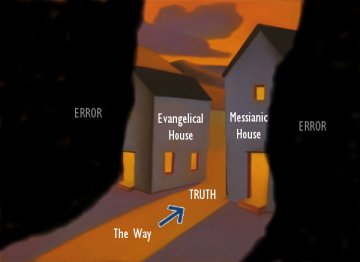
A controversy has arisen, originated by a staunch Seventh-day Adventist missionary called Benjamin G. Wilkinson (1872–1968), but now pretty much a Protestant-only affair, over the spiritual status of the King James Version. There are essentially three positions:
 1. THE KING JAMES-ONLY POSITION which maintains that the King James Version was especially preserved by Elohim (God) as a 100 per cent error-free version to be used, to the exclusion of all other versions, by the Christian Church. The 'King James Only' movement is advocacy by a loosely associated group of Protestant Christians, that the King James Version of the Bible is superior to other English translations, and that other versions, especially those based on Westcott and Hort's revision of the text of the Greek Testament, are not to be trusted and are based on corrupted manuscripts. Adherents of the movement believe that the KJV is the last and best of a series of translations based on what they consider the most reliable of Greek New Testament manuscripts, the Textus Receptus or 'Majority Text'. They believe that most new translations of the Bible are inferior to the King James, and are not as true to the original text. They disapprove of the versions which use the minority text known as the 'Alexandrian Text' or are based upon it. King James Only believers would say that the Alexandrian texts contain the accumulated corruptions of different scribes over many years, in a manner that the Aaronic priests and Masoretes would never have tolerated when making copies of the Scriptures. 1. THE KING JAMES-ONLY POSITION which maintains that the King James Version was especially preserved by Elohim (God) as a 100 per cent error-free version to be used, to the exclusion of all other versions, by the Christian Church. The 'King James Only' movement is advocacy by a loosely associated group of Protestant Christians, that the King James Version of the Bible is superior to other English translations, and that other versions, especially those based on Westcott and Hort's revision of the text of the Greek Testament, are not to be trusted and are based on corrupted manuscripts. Adherents of the movement believe that the KJV is the last and best of a series of translations based on what they consider the most reliable of Greek New Testament manuscripts, the Textus Receptus or 'Majority Text'. They believe that most new translations of the Bible are inferior to the King James, and are not as true to the original text. They disapprove of the versions which use the minority text known as the 'Alexandrian Text' or are based upon it. King James Only believers would say that the Alexandrian texts contain the accumulated corruptions of different scribes over many years, in a manner that the Aaronic priests and Masoretes would never have tolerated when making copies of the Scriptures.
They see the King James Version as the greatest English translation ever produced, needing no further enhancements, some even claiming that it was dictated word for word by the Ruach (Spirit) to the scholars that made it. They believe the 'Westcott and Hort' revision of the Received Text to be a deliberate change to the text of the Greek Testament by 'irresponsible scholars' because of personal animosity for the Textus Receptus. They believe that modern translators have conspired to corrupt Scripture and lead believers away from the true Christian faith and cite alleged flaws in the modern English translations which originated in Alexandria, Egypt identified with Origen, Westcott-Hort, and Aland, also called the Novum Testamentum Graece or critical text. They believe these Alexandrian manuscripts, such as the Codex Vaticanus, the Codex Sinaiticus and the Codex Alexandrinus, were used by Brooke Foss Westcott and Fenton Hort to create the critical text to undermine the validity of the Textus Receptus which was used as the Greek source for the King James Version as well as the Bibles before that;
 2. THE OLDEST MANUSCRIPT POSITION which maintains that the oldest manuscripts (MSS) of the Bible are the most reliable even though they are numerically in the minority (1 per cent of all MSS) and there is considerable variation between them. These are called MINORITY MS versions as opposed to MAJORITY MS versions (99% of all MSS). The KJV is the only Majority MS version in English and is based on what is also called the Textus Receptus or Received Text; and 2. THE OLDEST MANUSCRIPT POSITION which maintains that the oldest manuscripts (MSS) of the Bible are the most reliable even though they are numerically in the minority (1 per cent of all MSS) and there is considerable variation between them. These are called MINORITY MS versions as opposed to MAJORITY MS versions (99% of all MSS). The KJV is the only Majority MS version in English and is based on what is also called the Textus Receptus or Received Text; and
 3. THE KING JAMES-BEST POSITION which maintains that the King James Version is to date the best version because the Textus Receptus is the best MS. 3. THE KING JAMES-BEST POSITION which maintains that the King James Version is to date the best version because the Textus Receptus is the best MS.
There is a growing movement which takes the King James Only Position. It is a highly dogmatic, unscholarly and intolerent position that condemns (in a most unchristian way) all those who do not use the KJV, with some of its fanatical adherents claiming that those who have been saved using other Bible translations are not really saved at all. Worse, it is without biblical or historical foundation and is manifestly irrational. There are some who maintain, with considerable justification, that this position is cultic. As mentioned earlier, this movement was started by a Seventh-Day Adventist in order to defend preconceived Adventist doctrines (such as soul-sleeping) which were overturned by more accurate modern versions!
Bible scholar and expert on the KJV Only movement, James P. White, has made this observation:
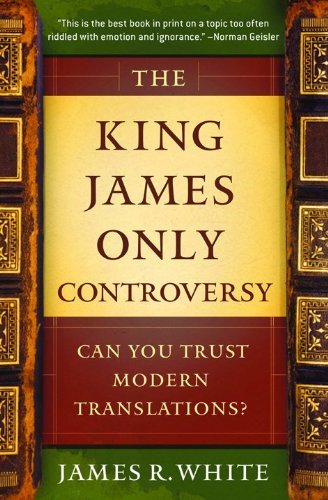 "The KJV Only controversy feeds upon ignorance among Christians regarding the origin, transmission, and translation of the Bible. Those who have taken the time to study this area are not likely candidates for induction into the KJV Only camp. Having a firm grasp of the issues that arise in transmitting an ancient text to the modern day and then translating that text from a rich foreign language into our less than rich English tongue is not only vital in providing an answer to KJV Only advocates, it is also extremely important to the Christian mission of our day. As we proclaim the gospel to an ever more skeptical world, we must be clear on why we believe the Bible to be God's Word. This calls us to be students of that book, requiring us to study its history and the reasons for our trust in its veracity and accuracy.
"The KJV Only controversy feeds upon ignorance among Christians regarding the origin, transmission, and translation of the Bible. Those who have taken the time to study this area are not likely candidates for induction into the KJV Only camp. Having a firm grasp of the issues that arise in transmitting an ancient text to the modern day and then translating that text from a rich foreign language into our less than rich English tongue is not only vital in providing an answer to KJV Only advocates, it is also extremely important to the Christian mission of our day. As we proclaim the gospel to an ever more skeptical world, we must be clear on why we believe the Bible to be God's Word. This calls us to be students of that book, requiring us to study its history and the reasons for our trust in its veracity and accuracy.
"The Christian who wishes to "give the reason for the hope" that is within him (1 Pet.3:15, NIV) will be quite alarmed at the logical conclusions derived from the KJV Only perspective...KJV Onlyism is forced to make statements about the Bible that undercut the foundations of the faith itself. Further, KJV Only supporters must downplay the importance of properly translating various passages of Scripture that are central to the demonstration of Christ's deity so as to maintain the alleged infallibility of the KJV (see chapter 8). Christians who believe that the faith is true and able to withstand scrutiny cannot allow such assertions to pass unchallenged" (James R. White, The King James Only Controversy: Can You Trust Modern Translations? - Bethany House, Minneapolis, Minnisota: 2009: p.17).
Dr.James White's book is the definitive study on the subject and is essential reading for Pastors, Bible-teachers and for all those who want to know the truth about the KJV-Only position. The book traces the development of Bible translations old and new and investigates the differences between newer versions and the Authorised Version of 1611. New and second-hand copies are easily obtainable online at Amazon and elsewhere.
Messianic Evangelicals believe, in common with the very King James Bible translators themselves (who would never have been KJV-Only), that the Davar Elohim (Word of God) is to be found in a variety of translations and that no one translation can claim to be exclusively the only correct one. They thought, most emphatically and unambiguously, that the Bible itself should be translated again and again, since it is more worthy of such work than any body of ancient literature. Consequently, the translators of the King James Version would be the first to affirm the importance of modern translations carrying on their legacy for the good of the Messianic Community (Church) and the advance of the Besorah (Gospel) in the world. Indeed, the KJV translators at 8,500 points included in the margins variations on how a passage could be translated (even as is done in some modern translations), as well as 9,000 cross-references to other portions of Scripture, and they believed that people having access to various translations is a very good thing. They suggested that the Kingdom of Elohim (God) does not hinge on a rigid rendering of individual words and syllables, but that there is freedom in translating the sense of the text. They further said that this freedom follows Yahweh’s own pattern of using various words to express the same ideas at different points in Scripture.

Because a lot of people are being misled and having their testimonies undermined by the King James-Only controversy, and because not everyone may take the step of buying Dr.White's excellent book, we have included a number of excellent articles and site links in this register that cover this question throughly. We are not the authors of most of these articles, and whilst the position of these authors on other topics is not necessarily always our own, we consider them to be excellent aids to understanding the KJV-Only problem. Written by a Baptist group calling itself the Pilgrimettes who encouraged copyright-free duplication, it's website is no longer to be found online for a credits link to be given here, something we will happily do in the event of their material reappearing or if we have inadvertantly missed it. So we wish to give a sincere thanks to Bob Ross at Pilgrim Publications for his hard work and excellent research.
We further wish to add that we are admirers of many King James-Only ministries and that our position on the KJV in no way detracts from these ministries' otherwise excellent services generally (e.g. Texe Marrs, William Schnoebelen, etc.). Our opposition to the KJV-Only position must never, furthermore, be construed to mean that we are against the KJV in any way - we regard it as one of the most beautiful translations into the English language that has ever been made and still of great value. Many of our people still use it, myself included.
Finally, it has to be pointed out most emphatically (because most KJV Onlyers are in denial of this truth) that the King James Bible which is sold in book shops today is not the original 1611 edition but a much later revision of the only version which they believe to be infallibly inspired. Indeed, the original 1611 KJV is no longer in print and has not been for a very long time. Since many KJV Onlyers believe that no one can be saved who has not used the original 1611 edition, it follows (using their logic) that nobody has been saved for a very long time indeed.
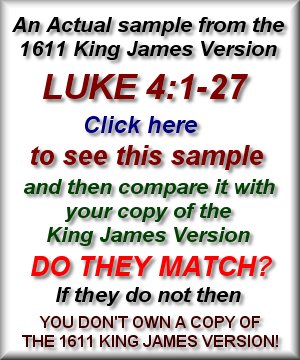 Carefully observe the contents of the
Carefully observe the contents of the
margins of this original 1611 edition -
these were later ordered removed
Since its publication in 1611, there have been over 1,700 corrections to translation and printing errors in the KJV, some dating before those used in translation. The original translators, for all their expertise and scholarship, had a limited knowledge of Hebrew and did not, as mentioned earlier, have access to many manuscripts (MSS) that were later discovered, some dating before those used in the translation. Those earlier MSS often showed the absence of text found in later MSS, indicating suspect additions by later scribes who made the copies. Many of these errors remain uniquely in the KJV today which to KJV-Onlyers confers a kind of bogus 'mystique' to them. They are used, without any objective warranty, to criticise all other versions.
The most famous of these afrementioned additions is the Comma Johanneum (1 John 5:7), which did not appear in any of the MSS before 1400, which probably means it was inserted by a Roman scribe to support the Catholic doctrine of the Trinity of which there is not a single mention in the whole Bible. There are those who maintain that other additions were made like Acts 8:37, Matthew 5:22, 1 Peter 2:2, Mark 16:9-20 and Matthew 28:19 but since these are to be found in the earlier original Aramaic text their omission is likely the fault of Greek scribes. The Comma Johanneum, which is absent from the Eastern Peshitta, is the only addtion we can make mention of with any certainty as a fake.
Just as the Bible cannot be read properly unless you are in the Ruach (Spirit), who openes the meaning of the Scriptures, so it cannot be translated correctly unless the translators' 'old man' has been crucified to be replaced by the mind of Messiah. Of course, this idea has been misused by KJV-Onlyers to claim that only the KJV-1611 is truly inspired even though the translators made no such claim themselves and the many errors in said translation undermine such a claim. Since there is no available infallible litmus test to measure any claim for the inspiration of a particular translation, including the KJV, the versions we opt for must remain within the personal domain.
|
61% OF THE KJV IS NOT
AN ORIGINAL TRANSLATION
The 1611 KJV 'translation' borrowed heavily from numerous sources. Only 39% of it is original translation work:
- 1. Wycliffe versions + his Englsih sermons: 4%
- 2. Tyndale's work, + the Matthew Bible: 18%
- 3. Coverdale's work + the Great Bible: 13%
- 4. The Geneva Bible + its revisions: 19%
- 5. The Bishop's Bible + its revision: 4%
- 6. All other versions before 1611: 3%
TOTAL: 61%
(The Geneva Bible - Facsimile of the 1560 edition, Introduction by Lloyd E.Berry, Hendrickson Bibles, Peabody, Massachusets: 2000, p.18)
|
In the meantime, in addition to checking out the articles below on the KJV-Only Controversy, we invite you to look at our personal choices by visiting the NCAY Bible Versions Website.
|





